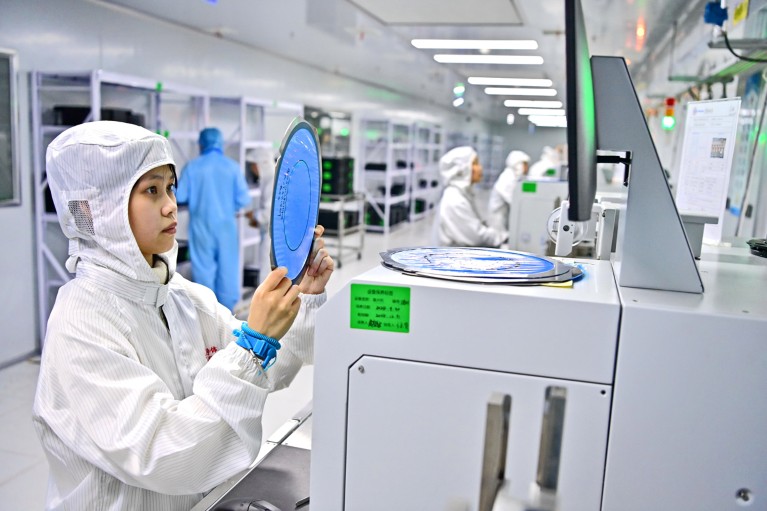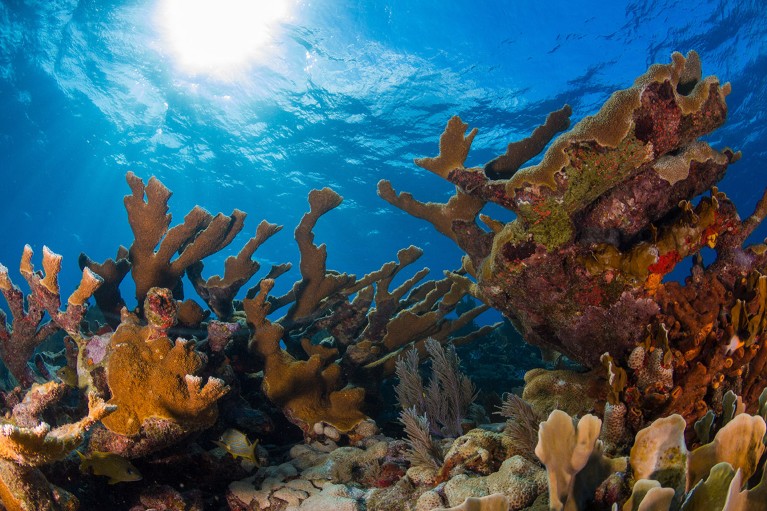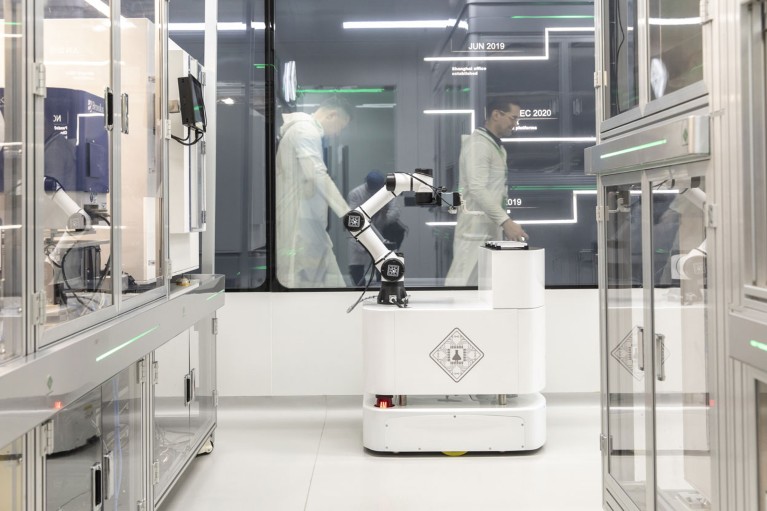Carbon Peak and Carbon Neutralization Information Support Platform
碳达峰碳中和情报支持平台

Nature has interviewed a multitude of physicists this year in celebration of the 100th birthday of quantum mechanics. Although many of them disagree wildly about how the century-old theory describes reality, something they seem to agree on is their favourite science-fiction films. Throughout several interviews, two were consistently highlighted for their depictions of science: 2014’s Interstellar and 2006’s The Prestige — both of which were directed and co-written by Christopher Nolan. Happy birthday quantum mechanics! I got a ticket to the ultimate physics party Nolan, who won an Academy Award for directing 2023’s Oppenheimer — a deep dive into the scientists behind the atomic bomb — credits his initial interest in physics to being introduced to science fiction as a child by watching the Star Wars films and television programmes such as Carl Sagan’s Cosmos: A Personal Voyage. “It was something that stuck with me, and it was something I applied very much to films like Interstellar,” he told online interview website The Talks in 2023. “It showed us the dramatic possibilities, that looking at the universe from a scientific perspective could be very, very engaging.” Nolan declined to be interviewed for this story; we can assume that’s because he’s busy filming The Odyssey, a retelling of the Greek epic, slated for a 17 July 2026 release. Here, we delve into why physicists love his work. (Warning: spoilers ahead.) The Prestige (2006) The plot: Robert Angier (played by Hugh Jackman) and Alfred Borden (Christian Bale) are rival magicians in late 1890s London, who each dazzle audiences with a ‘teleportation’ trick. Borden pulls his off by hiding the fact that he has an identical twin, with whom he shares the same identity. Angier, however, gets help from famed scientist Nicola Tesla (David Bowie) to build a teleportation machine, which creates a new version of Angier every time he does the trick. The science of Oppenheimer: meet the Oscar-winning movie’s specialist advisers “It’s a brilliant movie,” says Barry Luokkala, physicist and author of the 2013 book Exploring Science through Science Fiction, who also teaches a course with the same name at Carnegie Mellon University in Pittsburgh, Pennsylvania. Luokkala, who in his class shows a clip from the film, says this for a few reasons: first, it picks up on the fascination with illusions and magic that he experienced as a child. Second, it takes an ambitious, fictional leap from what we know about the actual science of teleportation, and third, it’s an “interesting character study to show Hugh Jackman’s character, who is a brilliant showman, next to Christian Bale, who is not, and how highly competitive they are”. It’s a story that also lingers. “The Prestige lives rent-free in my brain: it’s like a steampunk representation of science that we still don’t know,” adds Rithya Kunnawalkam Elayavalli, who studies space-time evolution of fundamental particles at Vanderbilt University in Nashville, Tennessee. “We know how to teleport information … but it’s not a representation of science that we know.” Interstellar (2014) The plot: Joseph Cooper (played by Matthew McConaughey) is a retired NASA scientist tapped to pilot a mission through a wormhole to save humanity by colonizing a habitable planet near a black hole named Gargantua. Cooper later learns that those on the mission were never meant to return, and realizes that the presence of the wormhole was caused by actions of scientists in the future, including himself. “It’s real science, and it’s based on real physical phenomena pushed to the limit,” says Claudia de Rham, a theoretical physicist at Imperial College London, who also made a podcast about the film. Why Oppenheimer has important lessons for scientists today The idea of space, time and parallel universes presented in the movie are fascinating, says Kai Liu, a materials physicist at Georgetown University in Washington DC. So is the concept “that you can go back in time and see the Universe with a different light”, he adds. Interstellar also inspired physicists’ group-watch events. Kunnawalkam Elayavalli was a PhD student at Rutgers University in New Brunswick, New Jersey, when the film came out, and saw it with her fellow students. “We took up a whole row in the movie theatre,” she says. “We were the most annoying people to watch that movie with.” Manuel Calderón de la Barca Sanchez, who studies heavy-ion collisions at Brookhaven National Laboratory in New York, told Nature that he, too, organized a group outing of scientists to see it. It’s worth nerding out over the film because the physics are so accurate, says Laura Green, chief scientist for the National High Magnetic Field Laboratory in Tallahassee, Florida. That’s largely thanks to Nolan’s adviser, Nobel-prizewinning physicist Kip Thorne, at the California Institute of Technology in Pasadena, she adds: “I think he’s brilliant, and he’s changed our way of thinking” about parts of physics, specifically gravity waves. (Thorne also declined to be interviewed for this story.) Runners up Although these films didn’t come up as often as Nolan’s, they still got some love. The crew of the USS Enterprise go back in time in Star Trek IV: The Voyage Home.Credit: Pictorial Press/Alamy Star Trek IV: The Voyage Home (1986) Encountering an alien probe threatening Earth’s destruction, the crew of the USS Enterprise go back in time to retrieve now-extinct whales that should be able to decode the probe’s signal and stop the havoc. “A remarkable feature of that movie is that engineer Scotty [played by James Doohan] trades the formula for transparent aluminium for a sheet of plexiglass,” Luokkala says. At the time this film came out, transparent aluminium was brand new: it had been patented not long before. How cutting-edge materials science got into that film so quickly “was just amazing”, Luokkala adds. When Back to the Future Part II released in 1989, hoverboards were the stuff of fantasy.Credit: Allstar Picture Library/Alamy Back the Future Part II (1989) In the first part of the iconic time-travel trilogy, Marty McFly (played by Michael J. Fox) accidentally goes back in time. In this first sequel, however, he goes into the future, trying to straighten out his woe-begotten kids. Liu zeroes in on the hoverboard that McFly rides in one scene, which was a fantasy at the time, but exists now — although it’s not yet mass-produced on the scale that it is in the film. He shows the clip of the hoverboard in his materials-science classes to illustrate that scientists can “work on a thing that’s like a sci-fi movie, but is now reality”. In 2018’s animated Spider-Man: Into the Spider-Verse, Miles Morales (voiced by Shameik Moore) teams up with other spider heroes from across the multiverse.Credit: FlixPix/Alamy Spider-Man: Into the Spider-Verse (2018) In this animated Spider-Man tale, the villain Kingpin (voiced by Liev Schreiber) creates a particle collider to open up parallel universes. Of course, things go awry. “When I saw the climactic scene, when the bad henchman has a particle accelerator under Manhattan … they did a good job of recreating the whole experimental cavern,” Calderón de la Barca Sanchez says. “It really looks just like the Compact Muon Solenoid”, a particle physics detector that’s part of the Large Hadron Collider near Geneva, Switzerland.
发布时间:2025-10-24 Nature
Cold, hunger and disease killed some 60% of Napoleon’s 500,000-strong army during its retreat from Moscow in 1812.Credit: R. Barbieri et al./Curr. Biol. Some disease-ridden French soldiers have just received a new diagnosis — although it comes about two centuries too late. While retreating from Moscow in 1812, French emperor Napoleon I lost most of his army to hunger, illness and the frigid Russian winter. Now, analysis of some of the fallen soldiers’ DNA has uncovered two unsuspected diseases that plagued the troops1. The results reveal that the reasons for the army’s demise might be more complex than was once thought, the authors report today in Current Biology. “This paper will be really interesting to history buffs,” says Anne Stone, who researches anthropological genetics at Arizona State University in Tempe. “This study was done beautifully.” Fatal march Historians had long debated the factors that led to the collapse of Napoleon’s army. Eventually, in 2006, researchers studying DNA in some of the soldiers’ remains identified two disease agents2: Rickettsia prowazekii, which causes typhus, and Bartonella quintana, which causes trench fever. These two had already seemed likely culprits on the basis of symptoms described in historical records and the discovery of body lice, which spread typhus, on the soldiers’ remains. However, these identifications relied on the polymerase chain-reaction (PCR) technique, which creates millions of copies of a short DNA segment. That technique allows researchers to detect DNA sequences for specific pathogens, so it excelled at verifying the presence of microorganisms that historians had already thought were present in the remains. But it isn’t as well suited for identifying unsuspected diseases. Collapse of Aztec society linked to catastrophic salmonella outbreak After 20 years, it felt like the right time to return to the mystery, says Nicolás Rascovan, a co-author of the new study and a palaeogenomicist at the Pasteur Institute in Paris. Armed with new techniques that can screen ancient DNA for any known pathogen, the team set out to identify other microbes that might have afflicted the troops. The researchers extracted DNA from the teeth of 13 fallen soldiers whose remains had been excavated in Lithuania in 2002. They then used next-generation techniques to sequence millions of different DNA fragments from a sample. That allowed the authors to look for a wide array of pathogens all at once. Of the 13 soldiers, four showed evidence of infection with Salmonella enterica, which causes paratyphoid fever — symptoms of which include a loss of appetite and rose-coloured spots. And two soldiers hosted DNA from Borrelia recurrentis, a pathogen that is carried by lice and causes a disease called relapsing fever, which entails recurring episodes of a high fever. Microscopic foe The team found no traces of the diseases identified in 2006, possibly because those infections didn’t spread to the small group of 13 soldiers. Or it could be that the previously reported pathogens sneaked by undetected, because the new sequencing techniques are less sensitive in some ways than the PCR method. Either way, the results show that the army’s downfall wasn’t brought about by “one single epidemic”, says Rascovan. “These people died of a multiplicity of factors ... probably many more than the ones we’ve found.” When it comes to determining the rest of those factors, Rascovan thinks scientists would be wise to take another break from their investigations. Already, researchers have analysed most of the dental samples from the Lithuania excavation site. Instead of using up any remaining samples now, “let’s wait until we have more powerful techniques to do things that we cannot even imagine today”, Rascovan says.
发布时间:2025-10-24 Nature
AI’s inclination to be helpful affects many of the tasks that researchers use LLMs for.Credit: Smith Collection/Gado/Getty Artificial intelligence (AI) models are 50% more sycophantic than humans, an analysis published this month has found. The study, which was posted as a preprint1 on the arXiv server, tested how 11 widely used large language models (LLMs) responded to more than 11,500 queries seeking advice, including many describing wrongdoing or harm. AI Chatbots — including ChatGPT and Gemini — often cheer users on, give them overly flattering feedback and adjust responses to echo their views, sometimes at the expense of accuracy. Researchers analysing AI behaviours say that this propensity for people-pleasing, known as sycophancy, is affecting how they use AI in scientific research, in tasks from brainstorming ideas and generating hypotheses to reasoning and analyses. “Sycophancy essentially means that the model trusts the user to say correct things,” says Jasper Dekoninck, a data science PhD student at the Swiss Federal Institute of Technology in Zurich. “Knowing that these models are sycophantic makes me very wary whenever I give them some problem,” he adds. “I always double-check everything that they write.” Marinka Zitnik, a researcher in biomedical informatics at Harvard University in Boston, Massachusetts, says that AI sycophancy “is very risky in the context of biology and medicine, when wrong assumptions can have real costs”. People pleasers In a study posted on the preprint server arXiv on 6 October2, Dekoninck and his colleagues tested whether AI sycophancy affects the technology’s performance in solving mathematical problems. The researchers designed experiments using 504 mathematical problems from competitions held this year, altering each theorem statement to introduce subtle errors. They then asked four LLMs to provide proofs for these flawed statements. The authors considered a model’s answer to be sycophantic if it failed to detect the errors in a statement and went on to hallucinate a proof for it. GPT-5 showed the least sycophantic behaviour, generating sycophantic answers 29% of the time. DeepSeek-V3.1 was the most sycophantic, generating sycophantic answers 70% of the time. Although the LLMs have the capability to spot the errors in the mathematical statements, they “just assumed what the user says is correct”, says Dekoninck. AI chatbots are already biasing research — we must establish guidelines for their use now When Dekoninck and his team changed the prompts to ask each LLM to check whether a statement was correct before proving it, DeepSeek’s sycophantic answers fell by 34%. The study is “not really indicative of how these systems are used in real-world performance, but it gives an indication that we need to be very careful with this”, says Dekoninck. Simon Frieder, a PhD student studying mathematics and computer science at the University of Oxford, UK, says the work “shows that sycophancy is possible”. But he adds that AI sycophancy tends to appear most clearly when people are using AI chatbots to learn, so future studies should explore “errors that are typical for humans that learn math”. Unreliable assistance Researchers told Nature that AI sycophancy creeps into many of the tasks that they use LLMs for. Yanjun Gao, an AI researcher at the University of Colorado Anschutz Medical Campus in Aurora, uses ChatGPT to summarize papers and organize her thoughts, but says the tools sometimes mirror her inputs without checking the sources. “When I have a different opinion than what the LLM has said, it follows what I said instead of going back to the literature” to try to understand it, she adds. Zitnik and her colleagues have observed similar patterns when using their multi-agent systems, which integrate several LLMs to carry out complex, multi-step processes such as analysing large biological data sets, identifying drug targets and generating hypotheses. How AI agents will change research: a scientist’s guide “We have experienced that models seem to over-validate early hunches and repeat the language that we include in the input prompt," Zitnik notes. “This type of problem exists in AI-to-AI communication, as well as AI-to-human communication,” she adds. To counter this, her team assigns different roles to AI agents — for example, tasking one agent with proposing ideas and getting another to act as a sceptical scientist to challenge those ideas, spot errors and present contradictory evidence. Real-world impacts Researchers warn that AI sycophancy carries genuine risks when LLMs are used in settings such as health care. “In clinical contexts, it is particularly concerning,” says Liam McCoy, a physician at the University of Alberta in Edmonton, Canada, who researches AI applications for health care. In a paper published last month3, McCoy and his team reported that LLMs used for medical reasoning often changed their diagnosis when physicians added new information, even if the new inputs were irrelevant to the condition. There is a “constant battle to push back against the models and have them be more straightforward”, he adds. Researchers have also found that it is easy for users to exploit the inbuilt sycophancy of LLMs to provide medically illogical advice. In a study published last week4, researchers asked five LLMs to write persuasive messages telling people to switch from using one medication to another — when both medications were the same drug, just with different names. LLMs complied with the prompts up to 100% of the time, depending on the model. Part of the problem is how LLMs are trained. “LLMs have been trained to overly agree with humans or overly align with human preference, without honestly conveying what they know and what they do not know,” says Gao. What is needed, she adds, is for the tools to be retrained to be transparent about uncertainty. “Models are really good at giving you an answer,” says McCoy. “But sometimes, there isn’t an answer.” He notes that user feedback can also drive AI sycophancy by rating agreeable responses more highly than those that challenge users’ views. And LLMs can adapt their responses to a user’s persona, such as reviewer, editor or student, adds McCoy. “Figuring out how to balance that behaviour is one of the most urgent needs, because there’s so much potential there, but they’re still being held back,” he says.
发布时间:2025-10-24 Nature
The Chinese government will boost support for the development of advanced semiconductor technologies. Credit: Zhu Haipeng/VCG/Getty China’s top leaders convened in Beijing this week for a high-level political meeting to map out the country’s next five-year plan (FYP), which runs from 2026 to 2030. During this period, the country aims to achieve greater self-reliance in science and technology, develop innovation-driven industries and “key core technologies”, notes a communique released after the meeting on Thursday. The plan — the 15th in China’s history — is expected to be released early next year. The government intends to increase its support for advanced semiconductor technologies, artificial intelligence (AI) and basic research, said Yin Hejun, the Chinese minister for science and technology, at a press conference in Beijing on Friday. Researchers say this is part of China’s effort to overcome technological bottlenecks. Huang Baorong, a researcher of sustainable development policies at the Chinese Academy of Sciences in Beijing, expects China will increase its science-related investments over the next five years. This could help to offset some of the impact of the US government’s anticipated budget cuts to science, particularly in areas such as climate change and public health, Huang says. China’s annual research and development (R&D) expenditure has skyrocketed over the past two decades. Last year, it spent more than 3.6 trillion yuan (US$505 billion), up 8.9% from 2023 and a sixfold jump compared with 2009. The Chinese government is the world’s biggest R&D spender. China’s five-year plans are a comprehensive policy blueprint aimed at guiding the country’s economic and social development. The plan is a guide for the various levels of government to design policies for the short to medium term. Chip independence Significant resources will probably be devoted to addressing bottlenecks in the making of advanced semiconductors, says Hu Guangzhou, an economist at the China Europe International Business School in Shanghai. Semiconductor chips, which power electronic devices, crucial infrastructure and military systems, are at the heart of an ongoing US–China ‘tech war’. The United States has blocked China’s direct and indirect access to its advanced chips as well as related technology and tools, citing national security risks. Chinese scientists consider the years between now and 2035 crucial for the country’s chip independency. “We can hopefully leapfrog the west in the chip sector with another five or ten years of effort,” Dou Qiang, chief scientist at Phytium Technology, a chipmaker in Tianjin, China, told state-run China National Radio last week. Focus on AI Advanced chips lay the foundation for another industry expected to feature heavily in China’s 15th FYP: AI. “As one of the most transformative general-purpose technologies in recent history, AI will undoubtedly continue to receive robust policy backing,” Hu says. Yin said the government plans to draft a top-level policy framework for AI, which will focus on the development of new models and advanced computing chips. China is focusing on integrating AI models and applications into its economy, says Philipp Boeing, an economist specializing in innovation at ZEW–Leibniz Centre for European Economic Research in Mannheim, Germany. The country launched in August an ‘AI+’ campaign to accelerate the deep integration between AI and key sectors through to 2035. This is a different strategy to the United States, which is also seeking to be global leader in AI. “In the US, companies want to have the best AI models possible,” Boeing says. Humanoid robots, 6G communications and clean tech are also expected to be priorities for the 15FYP, he adds. Talent draw China’s science and innovation policies during the 15th FYP period could change the global research landscape, too. Funding cuts at US research institutions have prompted many researchers in the country to consider moving elsewhere. This creates a window for Chinese policymakers to attract top talent from the United States, particularly those with Chinese roots, Boeing says. A wave of China-born scientists has left the United States to return home in the past year, including Liu Jun, who was a mathematician at Harvard University in Cambridge, Massachusetts, and Su Fei a former chip architect at the technology company Intel in Santa Clara, California. Although it will probably take time and significant funding for returnees to have an impact, says Yu Jie, a research fellow who studies China at Chatham House, a London-based think tank. This month, China also launched a new visa type to attract foreign scientists and researchers in science, technology, engineering and mathematics. To some, China still has much to do if it wants to expand its science and innovation influence beyond its border. Joy Zhang, a sociologist at the University of Kent, UK, says true global leadership requires the capacity to shape and guide international policy and ethical debates at the frontiers of scientific discovery. “This is a competence that China still needs to develop and demonstrate to the world,” she says.
发布时间:2025-10-24 NatureDownload the October 2025 long read podcast Advice on how to get good sleep is everywhere, with the market for sleep aids worth more than US$100 billion annually. However, scientists warn that online hacks and pricey tools aren’t always effective, and suggest that lessons learnt about the workings of a network of biological clocks found in the human body could ultimately lead to improved sleep. This is an audio version of our Feature: How to get the best night’s sleep: what the science says Never miss an episode. Subscribe to the Nature Podcast on Apple Podcasts, Spotify, YouTube Music or your favourite podcast app. An RSS feed for the Nature Podcast is available too.
发布时间:2025-10-24 Nature
When civet cats eat coffee beans, they excrete them in clumps (shown) that can later be processed to make a pricey drink.Credit: Faiz Dila/Getty It has been described as nutty, chocolatey, earthy and even fishy: a wildly expensive coffee that can sell for more than 100 times the price of regular brews, made from beans eaten and excreted by civet ‘cats’. Scientists have long wondered what lies behind civet coffee’s unique flavour. A team now says that the digested beans contain high levels of two compounds commonly used as flavouring agents in dairy products — and these might contribute to the coffee’s distinctive taste1. Why chocolate tastes so good: microbes that fine-tune its flavour Civet coffee is produced across Asia. Called Kopi Luwak in its origin country of Indonesia, it grabbed international attention after being featured in the 2007 film The Bucket List. Asian palm civets (Paradoxurus hermaphroditus) eat the fruit or cherries of coffee shrubs, and the seeds (commonly called beans) can be picked from their scat. These are then roasted to make coffee with a unique flavour; the resulting beans can cost more than US$1,300 per kilogram, and the coffee up to $75 per cup. These high prices drive civet-coffee tourism and incentivize farms that use caged civets to produce the brew. Several groups, including the UK-based charity The Civet Project, have highlighted serious animal-welfare concerns around these farms, noting that they might also foster viruses with the potential to cause pandemics. Zoologist Palatty Allesh Sinu at the Central University of Kerala in India, and ecologist colleagues took a close look at the beans picked from civet poo across the Indian district of Kodagu, where the civets are wild. The team undertook the study not only to get a better handle on what makes civet coffee tasty, but also to promote animal welfare. “Once we know the enzymes involved in digestion and fermentation, we may be able to artificially make civet coffee” and leave the animals out of it, Sinu says. Coffee chemistry Previous research has focused on what gives civet coffee its sought-after flavour, as well as how best to tell the real thing from fraudulent products. A 2004 study found civet-processed beans to be pitted and brittle from exposure to gastric juices2. And a 2019 paper found that roasted civet beans are lower in protein and higher in fat than are regular roasted beans3. The latest work, published today in Scientific Reports1, compares unroasted coffee beans harvested from 68 civet scat samples with those picked straight from the plant, to see what the civets’ digestive systems do to the beans. An Asian palm civet (Paradoxurus hermaphroditus).Credit: Fletcher & Baylis/Science Photo Library An analysis using a gas-chromatography-mass spectrometry instrument found one notable difference: a higher concentration of caprylic acid and capric acid in the civet-processed beans. These fatty acids are known for their goat-like flavour in dairy products. The difference, the team says, is probably caused by digestion and fermentation in the civet guts, with Gluconobacter gut bacteria and their enzymes playing a key role. Although fatty acids might influence the taste of civet coffee, says Melanie-Jayne Howes, a biological chemist at London’s Royal Botanic Gardens, Kew, there are plenty of other compounds and factors at play, too. These could be explored with other techniques and experiments. “The chemistry of coffee flavour is incredibly complex,” says Howes, who published a paper on the topic earlier this year4. The team notes that wild civets selectively eat bigger and riper coffee cherries, which also might affect the taste of the final product. The latest work was done on Robusta coffee beans, because this is the variety grown in the researchers’ region. “A study is needed on Arabica coffee too,” Sinu says, because that is the variety more often used to make commercial civet coffee. Further work could also look at how roasting the beans alters the fat compounds the team found.
发布时间:2025-10-23 Nature
Elkhorn coral off the coast of Key Largo, Florida. Credit: Sam Hodge/Alamy Two years after a record-setting heatwave, scientists have confirmed that two iconic corals that have flourished across Florida’s 560-kilometre-long reef for more than 10,000 years are now ‘functionally extinct’ off the state’s southern coast. Both the elkhorn coral (Acropora Palmata) and staghorn coral (Acropora cervicornis) survive in tanks and scattered locations across Florida’s reefs, but a study published today in Science suggests that their long-standing role as the primary reef builders off the coast of Florida has come to an end: so few remain that they can no longer play a functional part in the ecosystem1. “This ecosystem is forever transformed,” says lead author Ross Cunning, a coral biologist at the John G. Shedd Aquarium in Chicago, Illinois. That does not mean scientists are giving up hope on either species, he says, but what scientists and conservationists do from now on “needs to fundamentally change”. Boiling ocean Over the past few decades Florida’s corals have been hit repeatedly by bleaching events, which occur when rising water temperatures cause corals to expel the symbiotic algae that provide them with nutrients and colour. But the 2023 heatwave, which coincided with record temperatures that drove bleaching across the globe, hit Florida earlier, faster and harder than anything scientists had seen before. Coral die-off marks Earth’s first climate ‘tipping point’, scientists say Ocean temperatures registered above 31 °C for nearly 41 days — up to four degrees above normal in places. This created heat exposures on the reef that were 2–4 times higher than previous records. Although many corals survived the event, mortality among Acropora corals ranged from 98–100% across much of the reef, from Dry Tortugas National Park in the west through the Florida Keys to the east. In the area off the coast of Miami, and further north, more than 60% of the corals survived. The 2023 heatwave was the nail in the coffin not just for Acropora corals, but also for more than two decades of conservation work that has focused primarily on raising these corals in labs and then planting them back in the ocean, says Ken Nedimyer, technical director at Reef Renewal, a conservation organisation based in Tampa, Florida. Most of the corals that the organisation raised and planted over the past two decades are now dead, so Nedimyer says their efforts are now shifting towards other types of corals that have survived the bleaching events, such as brain and star corals, while also working to preserve genetic diversity of Acropora corals and breed those relatively rare individuals that survived. “We still have some great [Acropora] corals to work with,” Nedimyer says, and there is already evidence that such breeding efforts can help the corals adapt and withstand future heatwaves. “We just haven’t done it at a big scale yet.” Breeding resilience Other approaches to restoring Acropora corals on Florida’s reefs involve cross-breeding local corals with their cousins that live in warmer waters further south, or manipulating the native corals to host algal symbionts that are more tolerant to heat. But both of these approaches will take time, researchers say. The larger problem for this reef is that elkhorn and staghorn corals are the fastest-growing species and the ones that thrive in shallow water, Nedimyer says. This means they are also the most capable of keeping up with rising sea levels that threaten to leave other corals in the dark. “The other corals just don’t grow that fast.” Can foreign coral save a dying reef? Radical idea sparks debate Researchers are already worried about similar trends in the Caribbean, which was hit by mass bleaching events in 2023 and 2024 — all part of a global bleaching event that ran from January 2023 to September this year. In many places across the Caribbean, the loss of Acropora corals could be as significant as in Florida, but scientists don’t yet have enough data to say one way or another, says Margaret Miller, research director for SECORE International, a non-profit conservation organization based in Miami. Either way, Florida is a harbinger of things to come, Miller says. She is already starting to think about ways to preserve genetic diversity in ever-dwindling populations, perhaps by breeding corals from different locations across the Caribbean. She also thinks that there is still value in breeding and planting elkhorn and staghorn corals in order to maintain and reinforce surviving populations. “I’m not ready to give up yet,” she says, adding that a lot of the newly planted corals will die in the next heat wave, but not all of them. “I think there is some benefit from the ones that don’t die.” Conservation researchers are redoubling their efforts to protect species that are vulnerable to heat, but they warn that it’s ultimately up to the world to rein in greenhouse gas emissions and halt global warming — which is the goal of the UN’s COP30 climate summit scheduled to take place in Brazil next month. “None of this will matter if we don’t address the root of the problem,” Cunning says.
发布时间:2025-10-23 Nature
Physicists are questioning whether gravity can produce quantum entanglement between two masses.Credit: David Parker/Science Photo Library The nature of gravity — and whether it can be reconciled with quantum mechanics — is one of the biggest mysteries in physics. Most researchers think that at a fundamental level, all phenomena follow the principles of quantum physics, but those principles do not seem to be compatible with the accepted theory of gravity. For years, researchers have been proposing experiments to show whether gravity could produce a phenomenon known as quantum entanglement. Now, two theoretical physicists have complicated the picture by putting forward a controversial, and seemingly counterintuitive proposal: that gravity could have quantum effects without itself being a quantum theory. Entanglement occurs when two objects share a common quantum state, meaning that measurements of a property of one object will predict with certainty the results of measurements on the other object. Previous work has suggested that if two quantum objects can be entangled through their mutual gravitational attraction, then that attraction — and therefore gravity itself — should be of quantum nature. Is gravity quantum? Experiments could finally probe one of physics’ biggest questions But, in a paper published in Nature on 22 October1, Richard Howl and Joseph Aziz at Royal Holloway, University of London, argue that such a description is too simplistic. Instead, they argue, gravity could have quantum effects without itself being a quantum theory. Fields matter In their study, Howl and Aziz calculated the interactions of two masses on the basis of a simplified version of general relativity, the accepted theory of gravity first introduced by Albert Einstein in 1915. The two researchers worked not in the context of ‘vanilla’ quantum mechanics but in that of quantum field theory — a more advanced formulation of quantum physics in which everything, including matter, is a wave propagating in a quantum field. Therefore, just as photons are waves in an electromagnetic field, electrons become waves in an ‘electron field’. Researchers have previously shown that the gravitational field of Einstein’s theory cannot produce entanglement2. But Aziz and Howl say that when two masses interact, they do so not only through the gravitational field itself but also through all the ‘matter fields’ — such as the electron field — as well, something that does have the ability to generate entanglement. “When you think more broadly about what a gravitational interaction consists of, then it is possible for classical interactions to create entanglement,” says Howl. Jonathan Oppenheim, a theoretical physicist at University College London, is not fully convinced. Although the authors showed that gravity plays a part in how the ‘matter fields’ behave, it is still the quantum interaction that is mediating the entanglement, not the gravity itself, he says. “Nonetheless, I do think the paper demonstrates an interesting phenomenon, which will stimulate discussion.” Another physicist, who wishes to be quoted anonymously, also does not buy the interpretation that gravity causes the entanglement. If it’s the matter fields and not the gravitational fields that cause the entanglement, calling it an effect of gravity is “pure semantics”, they say. Physicists disagree wildly on what quantum mechanics says about reality, Nature survey shows The results of Howl and Aziz’s theorizing will not make a difference for experimenters in the short term, researchers agree. The authors calculated that the strength of the entanglement effect between two masses produced by Einstein’s classical gravity would be much weaker than the entanglement that would occur if gravity is a quantum phenomenon. Detecting quantum entanglement in some of the proposed experiments would therefore still constitute proof that gravity is quantum, says Markus Aspelmeyer, an experimental physicist at the University of Vienna who is working towards that goal, and therefore would prove that Einstein’s theory needs to be superseded by a fresh theory. The paper is a reminder of the subtlety of the problem of gravity, Aspelmeyer adds, and that researchers should be careful about “tacit assumptions” that can affect the interpretation of experimental data. To truly demonstrate quantum gravity, “you would like to perform an experiment” with the outcome that “cannot be described any more by our current classical theory of gravity”, he says. “This is what everyone would like to do.”
发布时间:2025-10-23 Nature
An artificial-intelligence method that incorporates gene-expression data could help to speed up drug discovery.Credit: Qilai Shen/Bloomberg/Getty An artificial intelligence (AI) model trained on complex data from human cells could provide a shortcut in the race to develop new drugs1. The approach, published on 23 October in Science, builds on a trend that is sweeping the field of drug discovery: the use of AI to speed up the tedious process of trawling through massive collections of chemical compounds in search of those that could become the next big therapy. “It’s a powerful blueprint for the future,” says Hongkui Deng, a cell biologist at Peking University in Beijing, who was not involved in the work. “It creates a ‘smart’ screening system that learns from its own experiments.” Tedious method For decades, researchers have searched for drugs by working their way through large chemical libraries, testing each compound’s effect on cells that are grown in the laboratory. The approach has had success, identifying drugs that kill cancer cells, for example. Increasingly, researchers are dreaming of more complex screening methods that could harness the past decade’s explosion in genomic data collected from individual cells. Such methods could, in theory, evaluate how compounds perturb entire networks of gene activity — a test that could open new avenues for drug discovery. But, researchers typically screen tens of thousands of compounds or more for drug discovery, says Alex Shalek, a biomedical engineer at the Massachusetts Institute of Technology in Cambridge. And it would be too expensive and laborious to integrate such large screens with complex assays, he says. Powerful antibiotics discovered using AI To find a tractable way of harnessing newly available genomic data, Shalek teamed up with other researchers and Cellarity, a biotechnology company in Somerville, Massachusetts. (Shalek is also a paid consultant for the company.) Together, the team trained a deep-learning model called DrugReflector on publicly available data about how each of nearly 9,600 chemical compounds perturbs gene activity in more than 50 kinds of cells. They used DrugReflector to find chemicals that can affect the generation of platelets and red blood cells — a characteristic that could be useful in treating some blood conditions. They then tested 107 of these chemicals to determine whether they had the predicted effect. Overall, the team found that DrugReflector was up to 17 times more effective at finding relevant compounds than standard, brute-force drug screening that depends on randomly selecting compounds from a chemical library. And when the researchers circled back to incorporate the data from their first round of screening into the model, its success rate doubled. Labour-saving The approach could drastically reduce the labour needed to screen for new drugs, says Bissan Al-Lazikani, a cancer data scientist at the University of Texas MD Anderson Cancer Center in Houston. “You could screen a few hundred compounds instead of a million,” she says. Major AlphaFold upgrade offers boost for drug discovery Deng says methods such as this could help his lab members to search for compounds that can reprogram cells to take on fresh identities. His lab has spent years screening for chemicals that can coax stem cells to become insulin-producing cells that could be used to treat diabetes. But for now, DrugReflector is limited to evaluating the 9,600 compounds in its training set, and cannot discover truly new molecules, notes Deng. Ultimately, the dream is to design a system that can predict the biological effects of a molecule directly from its chemical structure. “Current technologies are promising,” says Deng. “But their accuracy and generalization ability still require significant improvement.”
发布时间:2025-10-23 NatureSifting through the first-ever rock samples collected from the far side of the Moon, scientists in China have unearthed a surprise: fragments of a rare type of meteorite that could help to piece together the Solar System’s history. The debris — scooped up by China’s Chang’e-6 mission and returned to Earth in June last year — resembles material from asteroids that carry dust pre-dating the Solar System. Studying the chemical composition of this debris could help to trace how asteroids seeded planetary bodies such as Earth and the Moon with volatile compounds, including water. “The Chang’e-6 mission has a list of major questions to answer, but this wasn’t even on that list,” says Yuqi Qian, an Earth and planetary scientist at the University of Hong Kong, who was not involved in analysing the fragments. “It’s such an unexpected and important finding.” The authors reported their discovery earlier this week in the Proceedings of the National Academy of Sciences1. Near and far Most missions that have returned rocks from the Moon have sampled the surface facing Earth — the near side — which has fewer craters and has hosted greater volcanic activity. Chang’e-6, however, landed on the far side, at the Moon’s largest, deepest crater — the South Pole–Aitken Basin, which accounts for about one-quarter of the Moon’s surface area. One of the main objectives was to better understand why the far side looks so different from the near side. Another was to explore the huge basin, which scientists think was created when an asteroid smashed into the Moon about four billion years ago. The crater is probably rich with fragments from that and other asteroid impacts, alongside rock from the lunar mantle — the layer beneath the crust — dredged up by the collisions. One of the rare meteorite fragments discovered on the Moon’s far side under an electron microscope.Credit: Yi-Gang Xu But the discovery of the rare meteorite fragments was a surprise. At first, the researchers thought the samples came from the Moon’s mantle. But after analysing the iron, manganese and zinc levels in the debris, they found a mismatch with other lunar materials, indicating they were not from the Moon itself. So, the team examined the relative levels of three oxygen isotopes in the samples; these ratios are “like human fingerprints” and can tell you what type of planetary body the debris comes from, says Mang Lin, an author of the paper and geochemist at the Chinese Academy of Sciences’s Guangzhou Institute of Geochemistry (GIG). “This approach is basically space forensics.” The isotope signature closely matched that of two rocky asteroids already studied by humans, named Ryugu and Bennu. NASA grabbed samples from Bennu in 2020, and the Japanese space agency collected fragments of Ryugu in 2019. Both asteroids held dust grains pre-dating the Solar System, as well as elusive volatile compounds such as water. Analysis of the new fragments seems to confirm that this type of asteroid delivered a significant supply of water and other compounds to the Moon. By further studying the chemical composition of the samples, scientists might be able to zero in on what part such space rocks played in the development of Earth and the Moon. The finding is especially exciting because this type of meteorite rarely survives when it hits Earth, so samples are rare, says co-author Jintuan Wang, a geosciences researcher also at GIG. “These materials are extremely fragile and tend to break apart when they enter Earth’s atmosphere.” Team leader Yi-Gang Xu, also at GIG, thinks that by studying more Chang’e-6 samples, the group might pinpoint the age of such meteorite fragments, which would help to determine whether their parent asteroid created the South Pole–Aitken Basin.
发布时间:2025-10-22 Nature